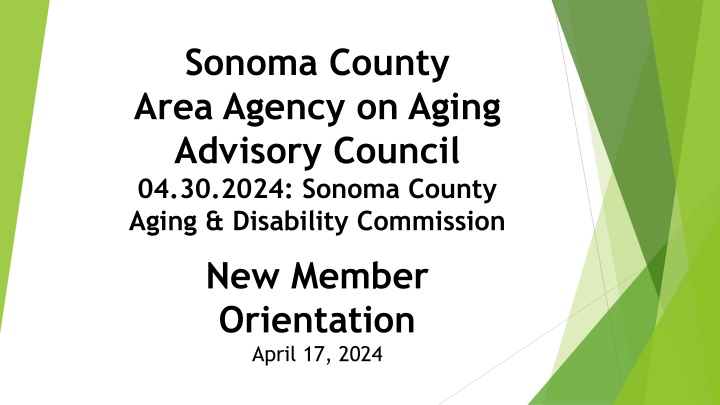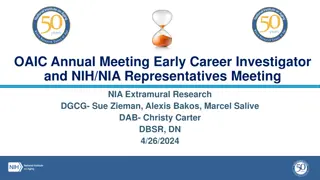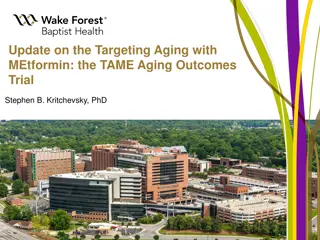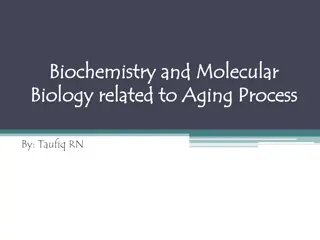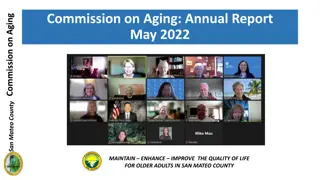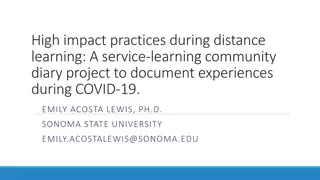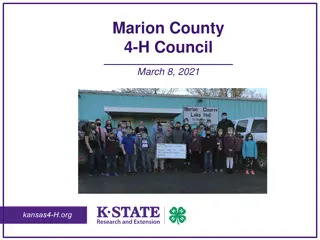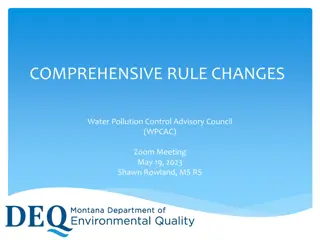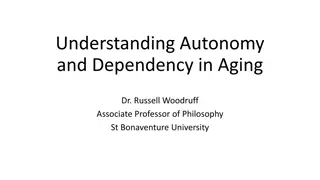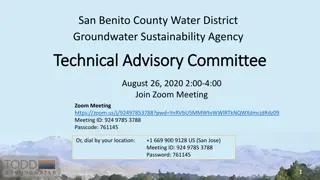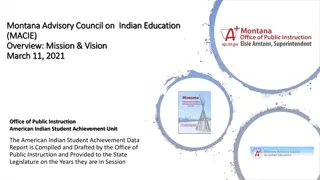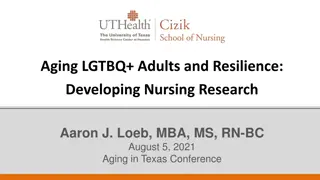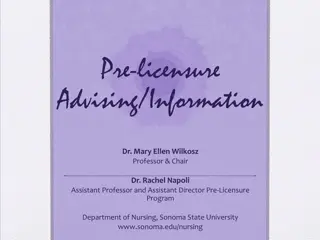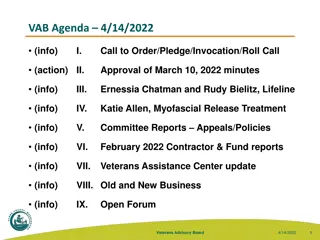Sonoma County Area Agency on Aging Advisory Council Meeting Highlights
Sonoma County Area Agency on Aging Advisory Council recently held a meeting welcoming new members and discussing important topics such as land acknowledgment, area plan approval, demographics, and the aging & disability network. The meeting also highlighted projections for the older adult population in Sonoma County, emphasizing the need for continued support and services for this demographic.
Download Presentation

Please find below an Image/Link to download the presentation.
The content on the website is provided AS IS for your information and personal use only. It may not be sold, licensed, or shared on other websites without obtaining consent from the author.If you encounter any issues during the download, it is possible that the publisher has removed the file from their server.
You are allowed to download the files provided on this website for personal or commercial use, subject to the condition that they are used lawfully. All files are the property of their respective owners.
The content on the website is provided AS IS for your information and personal use only. It may not be sold, licensed, or shared on other websites without obtaining consent from the author.
E N D
Presentation Transcript
Sonoma County Area Agency on Aging Advisory Council 04.30.2024: Sonoma County Aging & Disability Commission New Member Orientation April 17, 2024
Welcome! Area Agency on Aging Advisory Council Jenny Helman, Vice Chair Deanna Shaat, Secretary Area Agency on Aging Community Services Program Manager Katie Parrish, Outgoing Sara Avery, Incoming
Land Acknowledgement Land Acknowledgeme nt The County of Sonoma recognizes that we re on the ancestral lands of the Coast Miwok, Pomo and Wappo who are the original caretakers of this area. We respectfully acknowledge the Indigenous peoples who continue to steward and maintain relationship on this land as knowledge keepers.
Agenda Where You Fit In Opportunities to Learn Overview Aging & Disability Network, Service Network Sonoma County Demographics Area Plan Needs Assessment Human Services Department: Adult & Aging Division and the Area Agency on Aging Area Agency on Aging Advisory Council soon to be renamed the Sonoma County Aging & Disability Commission
Aging & Disability Network High Level California Commission on Aging https://ccoa.ca.gov/ Triple-A Council of California https://tacc.ccoa.ca.gov/
Service Network
2024-2028 Area Plan Being approved by the Board of Supervisors on April 30th. Available to access on the Advisory Council Landing Page This link will be updated once the Commission is renamed and webpage is updated. Read, Absorb, Ask Questions
Sonoma County Demographics Amplify!
# OLDER ADULTS & PROJECTED Age N = 60+ % of 60+ 60 64 39,732 65 69 31,327 70 74 31,722 75 79 16,503 80 84 11,584 85+ 11,264 CURRENT 28% of the Population 27% 25% 19% 12% 7% 9% Total population of Sonoma County 492,498 Total population of people age 60+ 138,132 % of people age 60+ 28% PROJECTED 35% of the Population by 2030 Total population of Sonoma County 521,303 Total population of people age 60+ 182,459 % of people age 60+ 35%
Demographics of Sonoma County
Older adults 60+, adults with disabilities and their caregivers Greatest Economic Need: income level at or below the federal poverty level Greatest Social Need: noneconomic factors that restrict and individuals s ability to perform daily tasks or ability to live indendently: Physical or mental disability Language barriers Cultural or social isolation caused by racial and ethnic status, sexual orientation, HIV status, gender identify or gender expression. Priority Populations Served by Funding
Financial Insecurity
Financial Insecurity in Sonoma County California has the highest rate of senior poverty in the nation. Older adults are struggling to make ends meet and stay in their homes, especially in the areas of California with the highest housing costs. Homelessness among California seniors is on the rise. Needs Assessment Priority Area: Justice in Aging
Area Plan: Needs Assessment Priority Areas & Survey Demographics
Needs Assessment Surveys: 1,679 Online and Paper English 1,565 Received Spanish 114 Received To Identify Funding & Initiative Priorities for the County Focus Groups: 14 Targeted groups included low-income housing communities, Spanish-speakers, Rural/Geographically isolated areas, Urban Areas, LGBTQIA+, Alzheimer s Disease & Caregivers, People with Disabilities & Caregivers. Stakeholder Interviews: 43 Leaders from Community Services & Supports, Health, Transportation, Housing, Caregiving, Emergency Preparedness, Protection from Abuse, and Economic Security.
Caregiving Health & Nutrition Needs Assessment 2024 2028 Top Concerns Housing & Transportation Access to Services Financial Stability
Human Services Department Adult & Aging Division and the Community & Administrative Services Section
Adult & Aging Budget & Services High Level View Nutrition*, Transportation, Caregiving, Safe Mobility Case Management, I&A Etc. Public Authority
Examples of community partnerships leveraged by Area Agency on Aging Access to Service through No Wrong Door Healthcare and social care integration Mental Health Elder Justice & Elder Abuse Prevention Fall Prevention Safe Mobility
Countywide Initiatives Aging & Disability Resource Hub (ADRH) No Wrong Door Local Master Plan for Aging (part of Aging Together) Local Aging & Disability Action Plan (LADAP) Age-Friendly & Blue Zones
Area Agency on Aging Advisory Council What is Your Why? How Will You Engage? How Can We Support You?
Sonoma County Area Agency on Aging (AAA) Planning & Service Area 27 21 Advisory Council Members Know Your District District 1 Supervisor Gorin District 2 Supervisor Rabbitt District 3 Supervisor Coursey District 4 Supervisor Gore District 5 Supervisor Hopkins
Advisory Council Statewide Structure Sonoma County Area Agency on Aging Advisory Council soon to be the Sonoma County Aging & Disability Commission CCoA serves as the principal advocacy body for older Californians and as a catalyst for change that supports and celebrates Californians as they age. Administers TACC. California Commission on Aging (CCoA) CCoA Values: 1. equity & inclusion 2. autonomy, choice & access 3. respect & integrity 4. collaboration & partnership. 25 appointees. Appointed by the Governor, Speaker of the Assembly & Senate Rules Committee Chair of the Advisory Council or their Delegated representative participate in Quarterly meetings. TACC mission is to promote communication and collaboration among advisory councils and key state partners. Triple A Council of California (TACC) Educate through exchange of information 2. Advocate on issues of concern in local/state planning 3. Strengthen the advocacy effectiveness and leadership skills of local advisory councils.
Structure of the Commission Commission 21 Members Understand AC Composition 10 members Board Appointed, 2 from each Supervisorial District 11 members Commission Elected Meetings 3rd Wed: Sept-Oct-Nov, Jan-Feb-March-April-May-June (no mtg Dec/July) Planning Day in August on the 3rd Wed (typically 9am to 2pm) Executive Committee 5 Members Chair, Vice-Chair, Secretary, Parliamentarian, Former Chair Meetings 2nd Tues: 1-Week Prior to Commission Meeting Set AC Agenda, Set Priorities for Commission Ad Hoc Committees (Workgroups) not ruled by Brown Act Time-limited, project specific work established by the AC through Motion Membership: Commission members only, less than a quorum of the AC Meetings as needed, via Microsoft Teams/Zoom
New Member Commission Mentors Know Your Council Mentor New members are assigned a mentor from the Commission s Executive Committee Membership Focus on the Why that brought you to membership support focus and purpose Support education and countywide perspective of services Schedule meetings following Commission meetings to debrief and ask questions Review Policy & Procedure and Bylaws questions Community Services Program Manager and Commission Chair are always available to support you and answer questions
Engagement & Education Know How to Engage & Learn About Services Monitoring (Formal) attend site visits to learn more about funded programs and experience services. Formal Monitoring is required by the California Department of Aging and coordinated by Staff. Commission members attend to support Staff and learn more about the programs. Site Visits (Informal) participate in services, schedule visits with providers (funded and unfunded), strengthen your knowledge and engagement with services and clients. Coordinated by Commission Members and/or Staff. Ad Hoc Committee(s) Standing Committee(s)
Required Trainings & Forms Get Your Training Done Security Awareness Training Local Ethics Training Conflict of Interest Form Oath of Office (Deputy Clerk of the Board) Parliamentary Guidelines Review Policy & Procedures Review (on your own questions to your Executive Committee Mentor)
Volunteer Hours Tracking Track Your Activities
Roles & Opportunities of Commission Members 1. Educate & Inform Yourself & Community Members about services and opportunities strengthen understanding about services and partnerships (i.e. site visits, focus groups, review materials and resources provided by Staff etc.) 2. Influence Program Development by Sharing Experiences & Community Contacts with Staff; 3. Advocate for Policy, Funding, Programs that support older adults, adults with disabilities and caregivers throughout Sonoma County (Request education from Staff) 4. Maintain connection with Board of Supervisors 5. Share ADRH and (707) 565-INFO (4636) Cards and other materials provided by Staff.
Advocacy is needed from Commission Members AAA staff can provide education and; AAA Advisory Council members can advocate AC Members are the voice for All older adults, adults with disabilities and caregivers throughout Sonoma County verb (used with object),ad vo cat ed, ad vo cat ing. to speak or write in favor of; support or urge by argument; recommend publicly: He advocated higher salaries for teachers.
Margaret Mead Never doubt that a small group of thoughtful, committed citizens can change the world. Indeed, it is the only thing that ever has.
Concept for strengthening advocacy AAA staff: Identify priority issues affecting older adults / people with disabilities Develop education / fact sheet on issue Support Agenda development & Bring items to Commission for a position / action At Commission request, staff may develop advocacy recommendations Consult Commission on funding opportunities and when a provider is severely out of compliance Provide training at Commission request Commission Members: Identify priority issues affecting older adults / people with disabilities By focusing on relevant conversations in their District or the County (i.e., committees, other council, calling a meeting with stakeholders) Request Community Services staff develop education / fact sheet on issue Bring items to Commission Meetings for a position statement / action Identify how to advocate How Can Staff Support You?
Examples of Advocacy Opportunities Board of Supervisors, City Council Meeting Public Comment Elder Justice Coalition, Mental Health Board (Countywide) City Council/Planning Commission (District-Level) Los Cien, NAACP, AAPI, Generation Housing, Disaster Planning (Countywide) Sonoma County Library, Promotores, Faith-Based, Education, Sonoma County Indian Health Program (SCIHP) Transportation Committees such as Sonoma County Transportation Authority - SCTA (City/County) Letter to the Editor in Local Papers & Press Democrat etc. Local Senior Advisory Commissions, Mental Health Board, Continuum of Care Board, Senior Center Boards, Section on Aging, Rotary to cross- pollinate between Commission and Local efforts Participate in funded programs engage with participants Grassroots Programs: Establish Ad Hoc in a shared area of interest Past Examples: Elder Protection Workgroup, Court Watch, Advance Care Planning, LGBTQIA+ How Do You Want to Engage?
Thank you! Questions?
